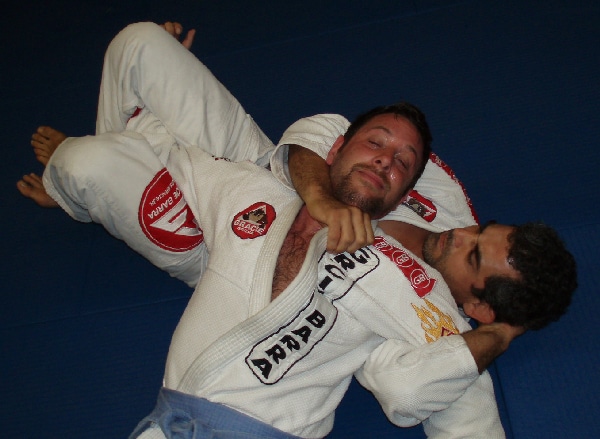
With the addition of the Crucifix Series, I felt I should address a common confusion people have when they try to discuss the crucifix.
The root of the problem is that two different positions share the same name.
One is legal at all levels of Brazilian Jiu-Jitsu and judo competition, while the other is a neck crank that is only legal in no-gi submission wrestling and mixed martial arts.
You can see how this leads to confusion when someone asks a question like “How do you escape the crucifix?” and people start telling him “Just tap! It’s not worth risking your neck!”, and he can’t figure out how a simple gi choke is going to do that.
A Tale of Two Crucifixes
The traditional crucifix is a position where you are laying behind your opponent, trapping one of his arms between your legs and the other with your arm. In judo, the choke from this position is called jigoku jime, which means “hell strangle”.
It is commonly gotten off a bad single leg (as we do here) and fireman’s carry or as a counter to the turtle.
Here’s a photo of the traditional crucifix:

Gary Goodridge catch Paul Herrera in this in UFC 8. If you saw it, you’ve probably never forgotten just how devastating it was. Here is a way to get into the crucifix position when your opponent turtles.
The other “crucifix” is similar in that the opponent’s arms are held out, but you are up on your knees and turned away from him, and you can put severe pressure on the neck. This neck crank version of the crucifix is also called the “cattle catch”, “stocks”, “reverse crucifix” and more.
If the internet doesn’t lie, Gene LeBell said this about this neck crank and its problem keeping just one name:
“Some people call this move a crucifix, some call it an iron cross, even a half cow catcher into a shoulder pin, and a hundred other names. In truth it does not matter what you call any technique as long as you can do the hold.”
You can get it as a counter to a single leg, off a failed guillotine or after a neck crank turnover. It can also be gotten from a tradition crucifix, as you can see in our Cattle Catch demonstration.
The neck crank crucifix looks like this:

As for its UFC appearance, Jerry Bohlander submitted Nick Sanzo with it in UFC 12. Here is one possible way to catch your opponent in the cattle catch. Or, if you want a fancier version of getting into the same position check out Denis Kang’s Rolling Crucifix vs Turtle (I have caught some very good people in this technique at least once)!
Due to the severely different nature and legality of these techniques, I prefer to differentiate between them by calling the traditional position the “crucifix”, and the neck crank the “cattle catch” for no better reason than those being my favorites.
Other Crucifixes
Other positions also share the crucifix name, usually because they prop the arms out and block the back of the neck. Examples of this include the leg crucifix and crucifix guard.
I hope this helps clear up the confusion that always happens when the crucifix is discussed.
Thanks to Eduardo de Lima for demonstrating this technique, and to Matt Kirtley for taking the photos and writing the descriptions. For more information, or to contact either person, please visit the Gracie Barra Tampa – Stephan Kesting.


